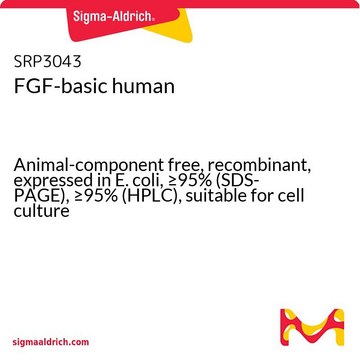F3685
Fibroblast Growth Factor-Basic, human
≥97% (SDS-PAGE), recombinant, expressed in E. coli, carrier free, suitable for cell culture
Sinónimos:
FGB-b, FGF-2, HBGF-2, HBGH-2, Prostatropin, bFGF
About This Item
Productos recomendados
Nombre del producto
Fibroblast Growth Factor-Basic, FGF-Basic, from human, recombinant, expressed in E. coli, carrier free
origen biológico
human
Nivel de calidad
recombinante
expressed in E. coli
Ensayo
≥97% (SDS-PAGE)
Formulario
lyophilized powder
potencia
<1 ng/mL Biological Activity EC50
mol peso
16.0 kDa
envase
pkg of 4X25 μg
pkg of 25 μg
condiciones de almacenamiento
avoid repeated freeze/thaw cycles
color
white to faint yellow cast
solubilidad
water: soluble 0.025 mg, clear, colorless to faintly yellow
Nº de acceso UniProt
temp. de almacenamiento
−20°C
Información sobre el gen
human ... FGF2(2247)
Descripción general
Código de clase de almacenamiento
10 - Combustible liquids
Clase de riesgo para el agua (WGK)
WGK 1
Punto de inflamabilidad (°F)
Not applicable
Punto de inflamabilidad (°C)
Not applicable
Elija entre una de las versiones más recientes:
¿Ya tiene este producto?
Encuentre la documentación para los productos que ha comprado recientemente en la Biblioteca de documentos.
Los clientes también vieron
Nuestro equipo de científicos tiene experiencia en todas las áreas de investigación: Ciencias de la vida, Ciencia de los materiales, Síntesis química, Cromatografía, Analítica y muchas otras.
Póngase en contacto con el Servicio técnico











